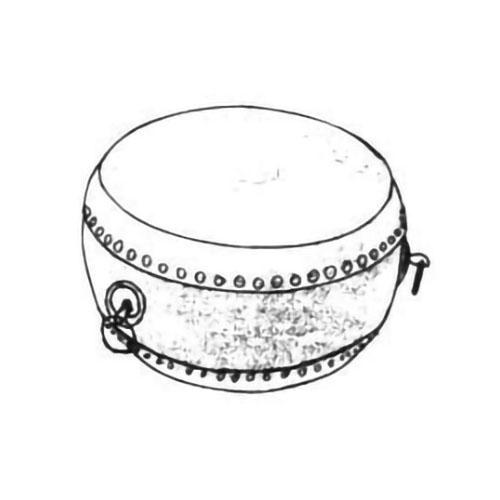Introduction to the classification of snare drums
317 views · Organized by 尼禄 on 2022-02-10
The small drums of various ethnic groups have different shapes due to different popular regions and occasions. They are mostly used in traditional ethnic festivals, weddings and funerals, and folk instrumental ensembles and opera accompaniment.

Zhuang drum
The small drum of the Zhuang nationality is popular in all parts of Guangxi, Guangxi Zhuang Autonomous Region. The drum frame is made of Chinese fir or miscellaneous wood. It is flat and round. The drum waist is slightly arched. Both sides are covered with cowhide. The leather surface is fixed with a single row of big hat copper nails. . The outer surface of the drum frame is painted with red lacquer, and three copper drum rings are placed around the drum waist. When playing, place the drum on a drum stand or a wooden bench, and play with a wooden drum in each hand. The pronunciation is short and the timbre is crisp. It is often used in the ensemble of eight music groups or as the accompaniment of Zhuang opera. It is an inseparable rhythm instrument. . It is also used in national festival celebrations or folk weddings and funerals.Tujia small drum
The small drum of the Tujia people, also known as the chess drum. It is popular in Hubei Province and Western Hubei Tujia and Miao Autonomous Prefecture and Hunan Province in Xiangxi Tujia and Miao Autonomous Prefecture. The drum frame is hollowed out from a whole section of sycamore or pine. Flat round. One or both sides are covered with cowhide or sheepskin, and the edges of the leather are fixed with drum nails. There are different specifications. The drum with single-sided skin has a drum surface diameter of 27 cm and a drum height of 15 cm; the double-sided skinned drum has a drum surface diameter of 35 cm and a drum height of 18 cm. There is a drum ring on each side of the drum frame. The two rings are connected by drum belts. The drum is made of wood, and the drum is 20 cm long and in the shape of a straight rod. When playing, the player hangs the drum belt around the neck, so that the drum surface is flat in front of the abdomen, and each hand holds a chime to play. In order to facilitate the performance during the march, a long bamboo piece is also surrounded on the outside of the drum frame, and the two ends of the bamboo piece are clamped on both sides of the player's waist to make the drum body stable. It is often used in traditional Tujia national festivals and folk weddings and funerals to form a percussion ensemble with hook gongs, liuzi gongs, winter gongs, head cymbals, two cymbals and other instruments, called flower gongs and drums, such as adding a suona To play, it is called playing gongs and drums. The chess piece drum plays a leading role in the above two ensembles, and is an important rhythm instrument of the Tujia people.snare drum
The snare drum, also known as the "snare drum", has the same importance as the bass drum in various bands and is often used at the same time as the bass drum. However, the small drum is not used to strengthen the upbeat like the big drum, but to strike a small rhythm on the upbeat to harmonize the timbre and enhance the rhythm of the music. The sound of the snare drum has strong sound penetration, and the intensity changes greatly. You can also change the timbre by covering the drum surface with flannel, or using drumsticks of different hardness, which can play various atmospheres and is very expressive.Involving musical instruments
Xiaogu (pinyin: xiǎo gǔ) is a musical instrument of the Zhuang, Dong, Yi, Tujia and other ethnic groups. Popular in Guangxi, Guizhou, Yunnan, Hubei, Hunan and other provinces. Snare drums are mostly used in the folk, and are used during Chinese New Year. It is basically the same as the big drum, except that the drum skin is made of sheepskin, and the side that does not strike is stretched with multiple strings; the drum drum uses two hardwood drums, and the drum head is smaller and does not contain any foreign objects.
Guess you like
Organized by 拙 on 2022-06-23
In the ancient city of Shouzhou, many gong and drum teams are active, and gong and drum performances are held during the festivals.
read >>
Organized by 一杯清酒 on 2022-06-22
On June 18, the 2022 Xianfeng County Cultural and Natural Heritage Day and the Cultural and Ecological Protection Experimental Zone construction achievements publicity and display activities were held in the Tangya Tusi City Site Scenic Spot.
read >>
Organized by 肖毅 on 2022-03-22
I'm used to reading fashion magazines and trendy brands, but today I'll show you something different. This is the twenty-one band from the Qing Dynasty that swept the world. You must not have thought that this Qing Dynasty band had debuted in the C position and led the fashion. Just the folk music playing and painting have been sold at home and abroad.
read >>
Organized by 雨童 on 2022-03-21
Bai folk instrumental music mainly includes sanxian music, suona wind and percussion music, cave scripture music, etc. In addition, there are also ancient music and tunes played by bamboo flute, mouth spring, wood leaf and so on.
read >>
Organized by ky on 2022-03-10
In ancient times, the drum was revered as a musical instrument that reached the sky, mainly as a sacrificial instrument; in hunting and expedition activities, the drum was widely used.
read >>
 渝公网安备 50010702504639号
渝公网安备 50010702504639号